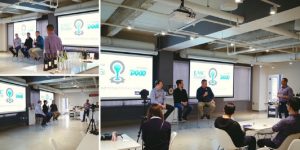Last week we held the official opening of the EMC Cloud Foundry Dojo in Cambridge, Massachusetts. The term ‘dojo’ is a Japanese word that translates to ‘the place of the way’. In our dojo, software developers learn and contribute to Cloud Foundry, the leading open source platform for Cloud Native Applications. The Cambridge dojo is also co-located with Pivotal Labs to help customers develop these applications via modern software practices. The pairing of cloud software and cloud platforms are key ingredients in leading businesses through their digital transformation journey.

Why is the dojo opening a significant milestone for EMC? First, it underscores EMC’s commitment to open source software. Open source is a key purchasing criteria for 3rd platform applications and infrastructure. During the second half of 2015, EMC emerged from a non-participating company to one of the top contributors to the Cloud Foundry open source. EMC is helping to enhance the governance, risk, and compliance requirements of Cloud Foundry for enterprise businesses.
Second, it demonstrates EMC’s ability to transform itself via a DevOps model. Cloud Foundry’s methodology is a combination of the ‘best-of-the-best’ modern software development practices including Agile, Lean, Extreme Programming, and CI/CD. All contributors to the open source community follow this ‘way’ of development everyday.
Third, but most importantly, the dojo is a key investment in one of the most critical components of cloud computing architectures – Cloud Foundry. Cloud Foundry gives customers freedom of choice. It enables their applications to run on multiple cloud providers ensuring cross-cloud portability.
The new digital world is very different and in some ways upside down. I’d like to reflect and pass on my learnings from the last 12 months to help you with your own digital transformation. So let’s cover people, process & technology in reverse order.
Technology Transformation – You Won’t Even Hear An Echo
Having spent many years in product development at EMC, I have crossed chasms from mini-computer to mainframe to client-server to cloud computing. The cloud computing chasm is, by far, the widest and deepest of all. In fact, it’s so big, you won’t even hear an echo. Sure, there are commonalities to client server architectures, however the application and infrastructure framework is very different today. The notion of the data center is quickly becoming an artifact of the past. Developers just want to push {my-app} to {my-cloud}. Abstraction levels are increasing and simplification is balancing out the complexity of software stacks. Yet we all know that making things simple is actually very complex.
What can help your business cross the chasm? Take a deeper look at Cloud Foundry for your cloud computing architecture. It provides a high degree of cloud infrastructure automation and it allows developers to simply push {my-app} to {my-cloud}.
Process Transformation – Learn By Doing
Like many of you, I grew up in a structured world of product development and program management. This world is built around a traditional lifecycle of ‘think-plan-do-check-and-correct’. In fact, if we’ve met, I’m sure you’ve heard my mantras around execution such as:
- Plan your work, work your plan
- Failing to plan is planning to fail
- The plan of record is the plan of record until the plan of record changes
- Plan the flight, review the plan, fly the plane, review the flight
However, the new digital world is very different. The speed and magnitude of change is ten times greater than the world in which we came from. Traditional methodologies focus on increasing predictability. However, with so much uncertainty and change in this new digital world, traditional approaches no longer apply.
What’s the answer? Learn by doing. The new world is premised upon lean start-up principles. The new lifecycle is ‘build, measure, learn, and iterate continuously’. Most transformational innovations don’t start with a plan to get you from point A to point B. They start by doing something, learning from it, and pivoting accordingly. The build-measure-learn model is more efficient and achieves customer acceptance sooner. It’s extremely rigorous, collaborative, and productive. You can achieve greater innovation, in less time, at a lower cost, with equal or better quality.
EMC and Pivotal Labs are helping customers in this transformation. Many CIOs recognize the value of a lean DevOps model, but struggle with starting and transforming their broader IT organizations. Our approach is to ignite brush fires across the organization. Build, measure, learn. If you never start, you’ll never get there.
Personal Transformation – Load The ‘Jump Program’
If you’re a fan of The Matrix Trilogy, it’s time to load the ‘Jump Program’. The new digital world is very different and requires new skills and values. I’ve had a few mile-wide jumps in my career. If you ever have a chance to take one of these opportunities, you should.
How do you make sure you can get to the other side? Jump with both feet, don’t look back, and when you get halfway across, keep going. Learn by doing.